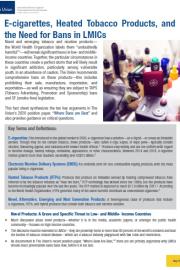
Novel and emerging tobacco and nicotine products—the World Health Organization labels them “undoubtedly harmful”1—will wreak significant havoc in low- and middle- income countries. Together, the particular circumstances in these countries create a perfect storm that will likely result in significant addiction, particularly among vulnerable youth. In an abundance of caution, The Union recommends comprehensive bans on these products—this includes prohibiting their sale, manufacture, importation, and exportation—as well as ensuring they are subject to TAPS (Tobacco Advertising, Promotion and Sponsorship) bans and SF (smoke-free) legislation.
E-CIGARETTES, Heated Tobacco Products, and the Need for Bans in LMICs. The Union, [s.l.], May, 2022. 4p.
In celebration of the World no Tobacco Day, the WHO FCTC Knowledge hub for Articles 17 and 18 has launched a campaign on the impacts of the tobacco production chain on the environment and workers' health.
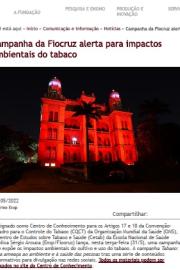
Designado como Centro de Conhecimento para os Artigos 17 e 18 da Convenção-Quadro para o Controle do Tabaco (CQCT) da Organização Mundial da Saúde (OMS), o Centro de Estudos sobre Tabaco e Saúde (Cetab) da Escola Nacional de Saúde Pública Sérgio Arouca (Ensp/Fiocruz) lança, nesta terça-feira (31/5), uma campanha que expõe os impactos ambientais do cultivo e uso do tabaco. A campanha Tabaco: uma ameaça ao ambiente e à saúde das pessoas traz uma série de conteúdos informativos para divulgação nas redes sociais. Todos os materiais podem ser baixados no site do Centro de Conhecimento.
CAMPANHA da Fiocruz alerta para impactos ambientais do tabaco. Fundação Oswaldo Cruz, Rio de Janeiro, 31 mai. 2022. Disponível em: https://portal.fiocruz.br/noticia/campanha-da-fiocruz-alerta-para-impact.... Acesso em: 1 jun. 2022.
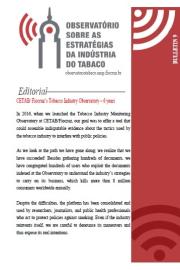
Bulletin nine published by the Center for Studies on Tobacco and Health of the Sergio Arouca National School of Public Health of the Oswaldo Cruz Foundation (Cetab/Ensp/Fiocruz). This edition consists of an editorial signed by Silvana Rubano Barretto Turci; Opinion: Who is interested in the transfer of Sister Lourdes Dill?; Electronic smoking devices (DEFs); Eduardo Leite: conflicting relations with the tobacco industry x Public Health and the radar column with the following headlines: book “Fight against tobacco in Brazil: 40 years of history” and Fiocruz Campaign promotes petition against the permission of cigarettes electronics in Brazil.
SIX years of CETAB/Fiocruz Tobacco Industry Monitoring Observatory [bulletin NINE]. Cetab/Ensp/Fiocruz, Rio de Janeiro, n. 9, 13 Apr. 2022.
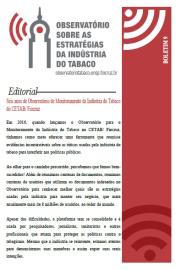
Boletim nove publicado pelo Centro de Estudos sobre Tabaco e Saúde da Escola Nacional de Saúde Pública Sergio Arouca da Fundação Oswaldo Cruz (Cetab/Ensp/Fiocruz). Esta edição é composta por um editorial assinado por Silvana Rubano Barretto Turci; Opinião: A quem interessa a transferência da Irmã Lourdes Dill?; Dispositivos eletrônicos para fumar (DEFs); Eduardo Leite: relações conflituosas com a indústria do tabaco x Saúde Pública e a coluna radar com as seguintes chamadas: livro “Luta contra o tabaco no Brasil: 40 anos de história” e a Campanha da Fiocruz promove abaixo-assinado contra a permissão de cigarros eletrônicos no Brasil.
SEIS anos de Observatório de Monitoramento da Indústria do Tabaco do CETAB/ Fiocruz [boletim NOVE]. Cetab/Ensp/Fiocruz, Rio de Janeiro, n. 9, 13 abr. 2022.
Responsible for the development of the National Health Policy in his native Pakistan, Dr. Ehsan Latif, now based in Scotland, has a long career on the boards of various public health entities and international groups in the field of lung health and tobacco control established under the Framework Convention for Tobacco Control and the World Health Organization including The Framework Convention Alliance, the Non-Communicable Disease Alliance, and most recently (2009-2017) he was senior advisor for noncommunicable diseases and director of tobacco control at the International Union Against Tuberculosis and Lung Diseases.
DR. Ehsan Latif: “WHO and FCTC Secretariat cannot sustain their current position”. The Vaping Today, Peru, 8 nov 2021. Disponível em: https://www.thevapingtoday.com/dr-ehsan-latif-who-and-fctc-secretariat-c.... Acesso em: 1 jul 2024.
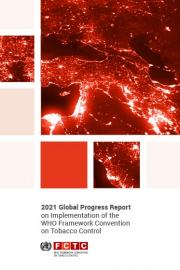
Este Relatório de Progresso Global de 2021 sobre a Implementação da Convenção-Quadro da OMS sobre O Controle do Tabaco é o nono de uma série de relatórios elaborados desde a entrada em vigor do Convenção-Quadro da OMS para o Controle do Tabaco (OMS FCTC) em 27 de fevereiro de 2005. O relatório foi desenvolvido enquanto a comunidade global lutava contra a doença coronavírus 2019 (COVID-19), a pandemia mais séria em mais de um século. Está sendo publicado em um momento em que o tabaco mais uma vez se mostrou mortal, não apenas por si só, mas também aumentando a morbimortalidade relacionada ao COVID-19, que é causada pela severa síndrome respiratória aguda coronavírus 2. A pandemia de COVID-19 afetou a saúde sistemas e economias em todo o mundo, com muitos hospitais e clínicas lutando para sustentar operações durante uma pandemia que ceifou mais de 4,3 milhões de vidas em todo o mundo.
2021 GLOBAL Progress Report: on Implementation of the WHO Framework Convention on Tobacco Control. Framework Convention
on Tobacco Control, [s.l.]. 2021. 196p.
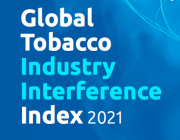
Enquanto os governos têm o poder de restringir regulamentos da indústria, infelizmente, o oposto parece ter acontecido nestes tempos difíceis. No muitos países, os governos têm protegido e até promoveu a TI. O tabaco já é o responsável por cerca de 8 milhões de mortes anuais em todo o mundo1 e saúde e as perdas de produtividade custam cerca de US $ 1,4 trilhão todos os anos. No entanto, os governos foram persuadidos a acomodar as demandas e lobby deste prejudicial indústria e aceitar sua caridade, conforme mostrado no Global Índice de Interferência da Indústria do Tabaco 2021 (o Índice).
GLOBAL Tobacco Industry Interference Index 2021. Global Center for Good Governance in Tobacco Control, Thialand, 2021, nov. 2021. 72p.
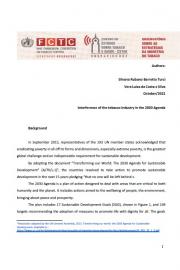
Agenda 2030 is an action plan designed to address critical areas for humanity and the planet. It includes activities aimed at the well-being of people, the environment, bringing peace and prosperity. The secretariat of the Framework for Tobacco Control (FCTC/WHO), understanding that the 17 SDGs are connected with the implementation of the convention, supports several measures of the 2030 Agenda through the execution of its articles. Among these measures are those established in the treaty's general obligations and in the treaty's central policies to reduce the supply and demand for tobacco, such as strengthening tobacco taxation (Article 6), protection against exposure to tobacco smoke (Article 8), the regulation of product packaging and labeling (Article 11) and the regulation of tobacco advertising, promotion and sponsorship (Article 13), among other articles.
INTERFERÊNCIA da indústria do tabaco na Agenda 2030. Cetab/Ensp/Fiocruz, Rio de Janeiro, out. 2021. 18p.
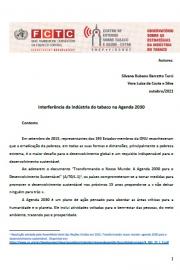
A Agenda 2030 é um plano de ação pensado para abordar as áreas críticas para a humanidade e o planeta. Ele inclui atividades voltadas para o bem-estar das pessoas, do meio ambiente, trazendo paz e prosperidade. O secretariado da Quadro para o Controle do Tabaco (CQCT/OMS), por compreender que os 17 ODS estão conectados com a implementação da convenção, apoia diversas medidas da Agenda 2030 através da execução de seus artigos. Entre estas medidas, estão as estabelecidas nas obrigações gerais do tratado e nas políticas centrais do tratado, de redução da oferta e da demanda por tabaco, como o fortalecimento da tributação do tabaco (Artigo 6), proteção contra a exposição a fumaça de tabaco (Artigo 8), a regulação das embalagens e etiquetagem dos produtos (Artigo 11) e a regulação da publicidade, promoção e patrocínio de tabaco (Artigo 13), entre outros artigos.
INTERFERÊNCIA da indústria do tabaco na Agenda 2030. Cetab/Ensp/Fiocruz, Rio de Janeiro, out. 2021. 17p.